Which of the following ecological locations, if destroyed, would result in the greatest loss of species diversity?
- A) tundra
- B) deciduous forests
- C) tropical rain forest
- D) grasslands
- E) islands
C
Estimates of current rates of extinction
- A) indicate that we have reached a state of stable equilibrium in which speciation rates equal extinction rates.
- B) suggest that one-half of all animal and plant species may be gone by the year 2100.
- C) indicate that rates may be greater than the mass extinctions at the close of the Cretaceous period.
- D) indicate that only 1% of all of the species that have ever lived on Earth are still alive.
- E) suggest that rates of extinction have decreased globally.
C
Extinction is a natural phenomenon. It is estimated that 99% of all species that ever lived are now extinct. Why then do we say that we are now experiencing an extinction (loss of biodiversity) crisis?
- A) Humans are ethically responsible for protecting endangered species.
- B) Scientists have finally identified most of the species on Earth and are thus able to quantify the number of species becoming extinct.
- C) The current rate of extinction is high, and human activities threaten biodiversity at all levels.
- D) Humans have greater medical needs than at any other time in history, and many potential medicinal compounds are being lost as plant species become extinct.
- E) Most biodiversity hot spots have been destroyed by recent ecological disasters.
C
Which of the following provides the best evidence of a biodiversity crisis?
- A) the incursion of a non-native species
- B) increasing pollution levels
- C) decrease in regional productivity
- D) high rate of extinction
- E) climate change
D
Although extinction is a natural process, current extinctions are of concern to environmentalists because
- A) more animals than ever before are going extinct.
- B) most current extinctions are caused by introduced species.
- C) the rate of extinction is higher than background extinction rates.
- D) current extinction is primarily affecting plant diversity.
C
Which of the following terms includes all of the others?
- A) species diversity
- B) biodiversity
- C) genetic diversity
- D) ecosystem diversity
- E) species richness
B
The difference between an endangered species and a threatened one is that
- A) an endangered species is closer to extinction.
- B) a threatened species is closer to extinction.
- C) endangered species are mainly tropical.
- D) only endangered species are vertebrates.
A
What is our innate appreciation of wild environments and living organisms called?
- A) biodiversity
- B) overharvesting
- C) biophilia
- D) conservation
- E) landscape ecology
C
Which of the following is the most direct threat to biodiversity?
- A) increased levels of atmospheric carbon dioxide
- B) the depletion of the ozone layer
- C) overexploitation of selected species
- D) habitat destruction
- E) zoned reserves
D
According to the International Union for Conservation of Nature and Natural Resources (IUCN), 73% of species have become extinct, endangered, vulnerable, or rare because of
- A) chemical pollution of water and air.
- B) stratospheric ozone depletion.
- C) overexploitation of certain species.
- D) alteration or destruction of the physical habitat.
- E) global climate change resulting from a variety of human activities.
D
What is the biological significance of genetic diversity between populations?
- A) Genes for adaptive traits to local conditions make microevolution possible.
- B) The population that is most fit would survive by competitive exclusion.
- C) Genetic diversity allows for species stability by preventing speciation.
- D) Isolated populations become more fit.
- E) Diseases and parasites are not spread between separated populations.
A
Overharvesting encourages extinction and is most likely to affect
- A) animals that occupy a broad ecological niche.
- B) large animals with low intrinsic reproductive rates.
- C) most organisms that live in the oceans.
- D) terrestrial organisms more than aquatic organisms.
- E) edge-adapted species.
B
How might the extinction of some Pacific Island bats called flying foxes threaten the survival of over 75% of the tree species in those islands?
- A) Flying foxes protect trees from herbivores.
- B) Flying foxes are increasingly hunted as a luxury food.
- C) Flying foxes spread disease between trees in a population.
- D) Flying foxes pollinate tree flowers and disperse seeds.
D
The introduction of the brown tree snake in the 1940s to the island of Guam has resulted in
- A) eradication of non-native rats and other undesirable/pest species.
- B) the extirpation of many of the island's bird and reptile species.
- C) a good example of biological control.
- D) a new species of hybrids from crossbreeding with a native snake species.
- E) its failure to compete with native species and its quick elimination from the island.
B
Which of the following examples poses the greatest potential threat to biodiversity?
- A) replanting, after a clear cut, a monoculture of Douglas fir trees on land that consisted of old-growth Douglas fir, western cedar, and western hemlock
- B) allowing previously used farmland to go fallow and begin to fill in with weeds and then shrubs and saplings
- C) lack of regulations to limit the harvest of the medicinal plant ginseng
- D) constructing oil and gas pipelines through old growth forest
D
Which of the following species was driven to extinction by overharvesting by hunters/fishermen?
- A) African elephant
- B) the great auk
- C) North American bluefin tuna
- D) flying foxes
- E) American bison
B
The wood turtle (Glyptemys insculpta) is a small, long-lived turtle that is endangered through much of its range in North America. As their populations shrink in size, it becomes even more difficult for turtles to find mates, and small populations have steadily become smaller. What best describes what the wood turtles in small populations are experiencing?
- A) overharvesting
- B) an extinction vortex
- C) habitat loss
- D) climate change
B
Which of the following conditions is the most likely indicator of a population in an extinction vortex?
- A) The population is geographically divided into many populations.
- B) The species in question is found only in small, stable pockets of its former range.
- C) The effective population size of the species falls below 500.
- D) Genetic measurements indicate a loss of genetic variation over time.
E) The population is connected only by corridors
D

Review the formula for effective population size,
Imagine a population of 1,000 small rodents. Of these, 300 are breeding females, 300 are breeding males, and 400 are nonbreeding juveniles. What is the effective population size?
- A) 1,000
- B) 1,200
- C) 600
- D) 400
- E) 300
C
f the sex ratio in a population is significantly different from 50:50, then which of the following will always be true?
- A) The population will enter the extinction vortex.
- B) The genetic variation in the population will increase over time.
- C) The genetic variation in the population will decrease over time.
- D) The effective population size will be greater than the actual population size.
- E) The effective population size will be less than the actual population size.
E
Which of the following can potentially influence effective population size (Ne)?
- A) length of life span after reproduction
- B) body size of individuals
- C) number of alleles per trait
- D) amount of gene flow between geographically separated populations
D
The word triage originated during World War I and was first used by French doctors in prioritizing patients based on the severity of their wounds because there were more wounded soldiers in need of urgent care than there were resources to treat them. Conservation biologists have to make similar determinations with degraded ecosystems. Which of the following is the most important consideration when it comes to managing for maintenance of biodiversity?
- A) identifying large, high-profile vertebrates first, because steps to saving them would be most recognized by the public
- B) determining which species is most important for conserving biodiversity as a whole
- C) altering habitat to be more suitable for a rare bird species
- D) maintaining optimum size of all populations in the ecosystem
B
The primary difference between the small-population approach (S-PA) and the declining-population approach (D-PA) to biodiversity recovery is
- A) S-PA is interested in bolstering the genetic diversity of a threatened population rather than the environmental factors that caused the population's decline.
- B) D-PA would likely involve bringing together individuals from scattered small populations to interbreed in order to promote genetic diversity.
- C) S-PA would investigate and eliminate all of the human impacts on the habitat of the species being studied for recovery.
- D) D-PA would use recently collected population data to calculate an effective population size.
A
Managing southeastern forests specifically for the red-cockaded woodpecker
- A) required the growth of a dense understory of trees and shrubs.
- B) included providing nesting cavities for breeding groups.
- C) caused other species of songbird to decline.
- D) involved strict fire-suppression measures.
- E) involved the creation of fragmented forest habitat.
B
Which of the following is true about the current research regarding forest fragmentation?
- A) Fragmented forests support a greater biodiversity because they result in the combination of forest-edge species and forest-interior species.
- B) Fragmented forests support a lesser biodiversity because the forest-adapted species disappear, and only the edge and open-field species can occupy fragmented forests.
- C) Fragmented forests are the goal of conservation biologists who design wildlife preserves.
- D) Harvesting timber that results in forest fragmentation results in less soil erosion.
- E) The disturbance of timber extraction causes species diversity to increase because of the new habitats created.
B
According to the small-population approach, what would be the best strategy for saving a population from extirpation?
- A) determining the minimum viable population size by taking into account the effective population size
- B) establishing a nature reserve to protect its habitat
- C) introducing individuals from other populations to increase genetic variation
- D) determining and remedying the cause of its decline
- E) reducing the population size of its predators and competitors
C
Relatively small geographic areas with high concentrations of endemic species and a large number of endangered and threatened species are known as
- A) nature reserves.
- B) movement corridors.
- C) biodiversity hot spots.
- D) extinction vortices.
C
How is habitat fragmentation related to biodiversity loss?
- A) Less carbon dioxide is absorbed by plants in fragmented habitats.
- B) In fragmented habitats, more soil erosion takes place.
- C) Populations of organisms in fragments are smaller and thus more susceptible to extinction.
- D) Animals are forced out of smaller habitat fragments.
- E) Fragments generate silt that negatively affects sensitive river and stream organisms.
C
Brown-headed cowbirds utilize fragmented forests effectively by
- A) feeding on the fruits of shrubs that tend to grow at the forest/open-field interface.
- B) parasitizing the nests of forest birds and feeding on open-field insects.
- C) roosting in forest trees and nesting in grassy fields.
- D) outcompeting other songbird species in fragmented communities.
- E) using forest cover to escape from predators in their normal grassland habitat.
B
Which of the following is consistent with forest fragmentation research?
- A) The number of species is the same in both fragmented forests and forest interiors.
- B) Edge communities consistently have low species diversity.
- C) Forest-interior species show declines in small patch communities.
- D) Landscapes dominated by small forest fragments support more species than continuous forest.
C
How are movement corridors potentially harmful to certain species?
- A) They increase inbreeding.
- B) They promote dispersion.
- C) They spread disease and parasites.
- D) They increase genetic diversity.
- E) They allow seasonal migration.
C
Biodiversity hot spots are not necessarily the best choice for nature preserves because
- A) hot spots are situated in remote areas not accessible to wildlife viewers.
- B) their ecological importance makes land purchase very expensive.
- C) a hot spot for one group of organisms may not be a hot spot for another group.
- D) hot spots are designated by the abiotic factors present, not the biotic factors.
- E) designated hot spots change on a daily basis.
C
The success with which plants extend their range northward following glacial retreat is best determined by
- A) whether there is simultaneous migration of herbivores.
- B) their tolerance to shade.
- C) their seed dispersal rate.
- D) their size.
- E) their growth rate.
C
As the climate changes because of global warming, species' ranges of plants in the Northern Hemisphere may move northward, using effective reproductive adaptations to disperse their seeds. The trees that are most likely to avoid extinction in such an environment are those that
- A) have seeds that are easily dispersed by wind or animals.
- B) have seeds that sprout quickly.
- C) produce seeds that contain large nutrient stores for growth.
- D) have seeds that become viable only after a forest fire.
- E) disperse many seeds in close proximity to the parent tree.
A
If global warming continues at its present rate, which biomes will likely take the place of the coniferous forest (taiga)?
- A) tundra and polar ice
- B) temperate broadleaf forest and grassland
- C) tropical forest and savanna
- D) tropical and temperate broadleaf forest
B
Which of the following investigations would shed the most light on the future distribution of organisms in temperate regions that are faced with climate change?
- A) Remove, to the mineral soil, all of the organisms from an experimental plot and monitor the colonization of the area over time in terms of both species diversity and abundance.
- B) Look at the climatic changes that occurred since the last ice age and how species redistributed as glaciers melted, then make predictions on future distribution in species based on past trends.
- C) Quantify the impact of humankind's activities on present-day populations of threatened and endangered species to assess the rate of extirpation and extinction.
- D) There is no scientific investigation that can help make predictions on the future distribution of organisms.
B
Burning fossil fuels releases oxides of sulfur and nitrogen. These air pollutants can be responsible for
- A) the increase of fish populations in lakes.
- B) precipitation with a pH as low as 3.0.
- C) biological magnification of toxins.
- D) preventing eutrophication.
B
How can human-caused environmental changes create problems for selecting a site for a preserve?
- A) Nutrient enrichment prevents preserves from being connected by corridors.
- B) The environmental conditions of almost any site may change because of climate change.
- C) Global warming makes all climates less suitable for maintaining high diversity.
- D) Only lands that are not useful to human activities are available for preserves.
B
What is a critical load?
- A) the amount of nutrient augmentation necessary to bring a depleted habitat back to its former level
- B) the level of a given toxin in an ecosystem that is lethal to 50% of the species present
- C) the maximum abundance level of a particular species beyond which additional numbers will degrade a habitat
- D) the amount of added nutrient that can be absorbed by plants without damaging ecosystem integrity
- E) the number of predators an ecosystem can support that effectively culls prey populations to healthy levels
D
The use of DDT as an insecticide in the United States has been outlawed since 1971, yet it is still a problem for certain top-level carnivores in the United States. Which of the following choices best explains this apparent incongruity?
- A) DDT is still used for mosquito control in tropical countries, and certain migratory predators can be affected by a seasonal biomagnification.
- B) DDT is persistent in the environment, and all of the pre-1971 DDT is still available in toxic form to poison top-level carnivores.
- C) Pre-1971 DDT has been deposited in certain habitats, particularly wetlands and estuaries, so predators in these ecosystems are vulnerable to biomagnifications of DDT.
- D) Whereas most DDT-susceptible species have become resistant to persistent DDT, others are still vulnerable.
A
Agricultural lands frequently require nutrient augmentation because
- A) nitrogen-fixing bacteria are not as plentiful in agricultural soils because of the use of pesticides.
- B) the nutrients that become the biomass of plants are not cycled back to the soil on lands where they are harvested.
- C) land that is available for agriculture tends to be nutrient-poor.
- D) grains raised for feeding livestock must be fortified and thus require additional nutrients.
- E) cultivation of agricultural land inhibits the decomposition of organic matter.
B
Which of the following refers to the reflecting and absorption of infrared radiation by atmospheric methane, carbon dioxide, and water?
- A) acid precipitation
- B) biological magnification
- C) greenhouse effect
- D) eutrophication
C
What is caused by excessive nutrient runoff into aquatic ecosystems?
- A) acid precipitation
- B) biological magnification
- C) greenhouse effect
- D) eutrophication
D
What causes extremely high levels of toxic chemicals in fish-eating birds?
- A) acid precipitation
- B) biological magnification
- C) greenhouse effect
- D) eutrophication
B
Considering the most important ecological issue of the future, what is the biggest challenge that Costa Rica will likely face in its dedication to conservation and restoration in the future?
- A) the pressures of its growing population
- B) its small size (as a country), which may not be able to maintain large enough reserves
- C) the potential for disturbance of sensitive species in reserves by ecotourists
- D) spread of disease and parasites via corridors from neighboring countries
- E) the large number of Costa Rican species already in the extinction vortex
A
Which of the following nations has become a world leader in the establishment of zoned reserves?
- A) Costa Rica
- B) Canada
- C) China
- D) United States
- E) Mexico
A
Which of the following best explains the reduction in human population growth rates over the past four decades?
- A) education on global famine
- B) improved worldwide health care
- C) voluntary reduction of family size
- D) improved sanitary conditions in the world's hospitals
- E) reduction of casualties of war
C
Which statement is true with regard to current human population growth?
- A) It is at a zero growth rate.
- B) Its rate of increase continues to grow at an exponential rate.
- C) Its rate of growth is slowing.
- D) Its rate of growth is increasing.
- E) There is no scientific prediction that can be made about human population growth.
C
The typical ecological footprint for a person in the United States is 8 global hectares (gha). How would you estimate the number of Earths required to support the entire population of the United States?
- A) Multiply the typical U.S. ecological footprint by the number of people who live there, and divide by the total global hectares of biologically productive land.
- B) Multiply the typical U.S. ecological footprint by the effective population size of the United States, and divide by the total global hectares of biologically productive land.
- C) Take the difference between the typical U.S. ecological footprint and the 1.7 gha sustainable ecological footprint, and multiply this difference by the number of people who live in the United States.
- D) Take the difference between the typical U.S. ecological footprint and the 1.7 gha sustainable ecological footprint, and multiply this difference by the total global hectares of biologically productive land.
A
The main goal of sustainable development is to
- A) involve more countries in conservation efforts.
- B) use only natural resources in the construction of new buildings.
- C) use natural resources such that they do not decline over time.
- D) reevaluate and re-implement management plans over time.
C
Which of the following best illustrates human efforts to improve environmental sustainability?
- A) rerouting major highways around cities to avoid traffic congestion
- B) increasing our reliance on renewable sources of energy
- C) upgrading computers every few years to improve performance
- D) converting automobiles from gasoline to natural gas as a new source of fuel
B
Which of the following best illustrates the sustainable use of a resource?
- A) Coal mines in West Virginia remove the tops of mountains to extract large amounts of coal.
- B) Fishing industries improve their methods and now remove more than 90% of the fish in a region.
- C) Huge windmills in Texas are able to capture 50% of the wind energy in a specific region.
- D) Corporations are converting their company automobiles from gasoline to natural gas, which is a less expensive fossil fuel.
C
The concept of sustainable development emphasizes
- A) the needs of future generations.
- B) trade between all nations of the world.
- C) the importance of developing the arts.
- D) the fastest ways to economic prosperity.
- E) the need for national government action.
A
Which of the following is the most sustainable source of energy?
- A) natural gas used to heat homes
- B) gasoline used to run cars
- C) solar panels on rooftops
- D) a coal power plant
C
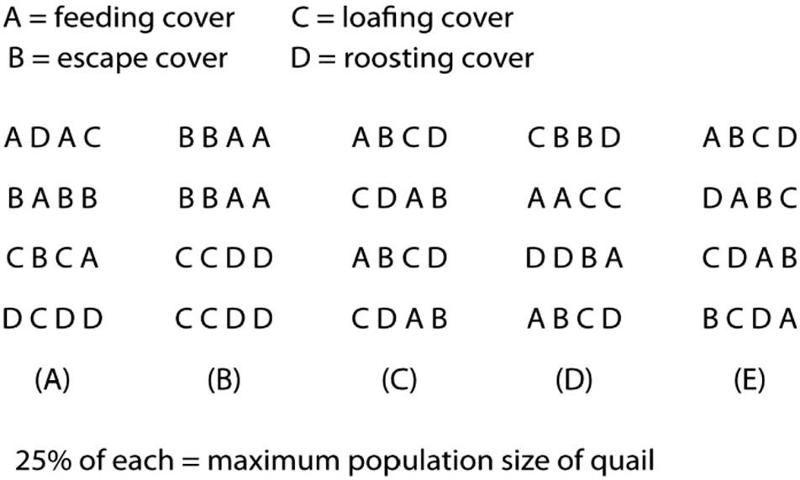
Figure 43.1 shows five patches that can potentially serve as quail habitat. Each patch contains four plots, and the types of cover that are available in each plot are listed in each row of the patch. Assuming that only one quail can occupy a plot where all cover requirements are met, what is the maximum number of quail that could inhabit all of the patches?
- A) 1
- B) 2
- C) 4
- D) 6
- E) 9
E
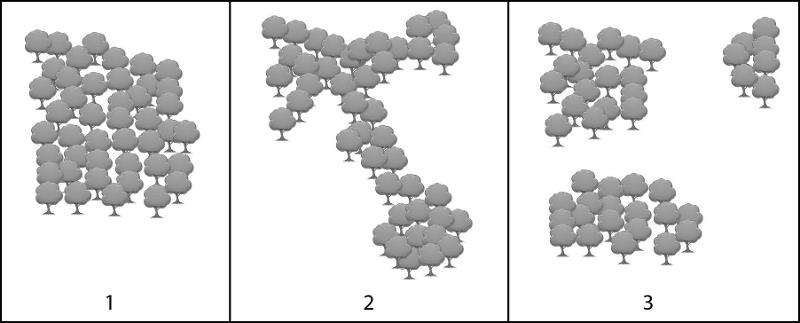
Which area(s) would be most suitable for conserving amphibians, which are highly susceptible to a pathogenic (disease-causing) chytrid fungus?
- A) 1 and 2
- B) 2 and 3
- C) 1 only
- D) 2 only
- E) 3 only
E
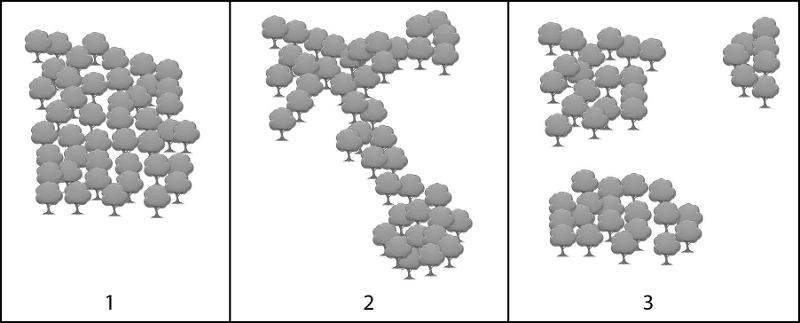
Which area(s) would be able to support the most scarlet tanagers, a bird species that is restricted to forest interior habitat?
- A) 1 and 2
- B) 2 and 3
- C) 1 only
- D) 2 only
- E) 3 only
C
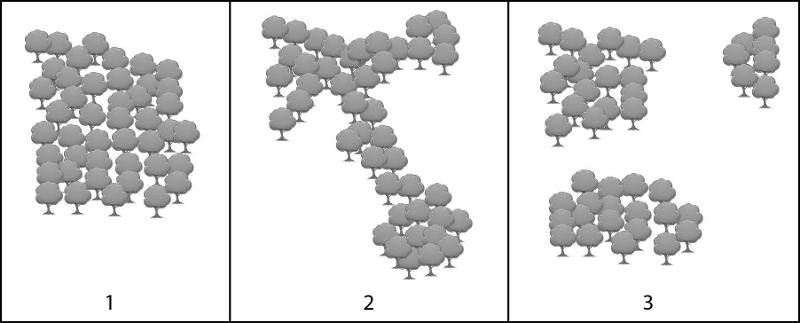
The American lady butterfly (Vanessa virginiensis) inhabits only forest edges and does not disperse well across unsuitable habitat. Which of the following area(s) would support the highest numbers of this butterfly?
- A) 1 and 2
- B) 2 and 3
- C) 1 only
- D) 2 only
- E) 3 only
D
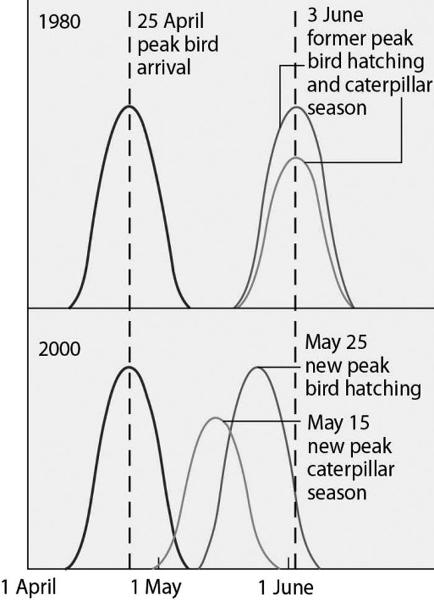
Flycatcher birds that migrate from Africa to Europe feed their nestlings a diet that is almost exclusively moth caterpillars. The graph in Figure 43.3 shows the mean (peak) dates of bird arrival, bird hatching, and caterpillar season for the years 1980 and 2000.
Flycatcher birds that migrate from Africa to Europe feed their nestlings a diet that is almost exclusively moth caterpillars. The graph in Figure 43.3 shows the mean (peak) dates of bird arrival, bird hatching, and caterpillar season for the years 1980 and 2000.
The shift in the peak of caterpillar season is most likely due to
- A) pesticide use.
- B) earlier migration returns of flycatchers.
- C) an innate change in the biological clock of the caterpillars.
- D) global warming.
- E) acid precipitation in Europe.
D
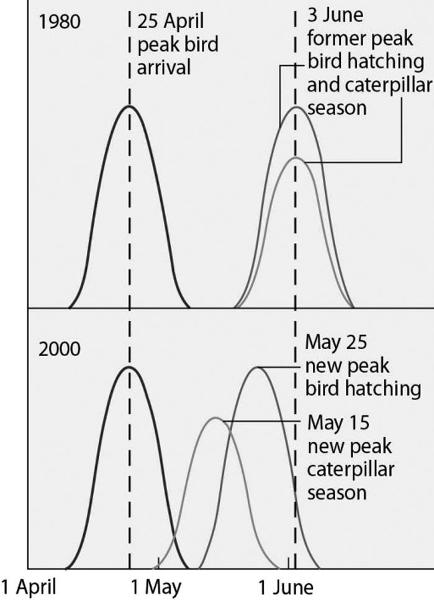
Flycatcher birds that migrate from Africa to Europe feed their nestlings a diet that is almost exclusively moth caterpillars. The graph in Figure 43.3 shows the mean (peak) dates of bird arrival, bird hatching, and caterpillar season for the years 1980 and 2000.
Why were ecologists concerned about the shift in the peak caterpillar season from June 3, 1980 to May 15, 2000?
- A) The caterpillars would have eaten much of the foliage of the trees where flycatchers would have nested, rendering their nests more open to predation.
- B) The earlier hatching of caterpillars would compete with other insect larval forms that the flycatchers would also use to feed their young.
- C) The flycatcher nestlings in 2000 would miss the peak caterpillar season and might not be as well fed, leading to population reductions.
- D) The flycatchers would have to migrate sooner to match their brood-rearing to the time of peak caterpillar season.
C
Suppose you attend a town meeting at which some experts tell the audience that they have performed a cost-benefit analysis of a proposed transit system that would probably reduce overall air pollution and fossil fuel consumption. The analysis, however, reveals that ticket prices will not cover the cost of operating the system when fuel, wages, and equipment are taken into account. As a biologist, you know that if ecosystem services had been included in the analysis the experts might have arrived at a different answer. Why are ecosystem services rarely included in economic analyses?
- A) People take them for granted because we generally do not pay for them.
- B) They are not worth much and would not greatly change the cost-benefit analysis.
- C) There are too many variables to include in ecosystem services, making their calculation impossible.
- D) Ecosystem services only take into account abiotic factors that affect local environments.
A
The contamination of soils with heavy metals has become more common as a result of the burning of fossil fuels, industrial activities, and agricultural fertilizer application. These heavy metals can be toxic depending on the concentrations that accumulate in an organism. A scientist hypothesizes that biological magnification of heavy metals in fragment-dwelling, insect-eating birds should be greater in forest fragments with relatively more edge habitat because edge-dwelling bird species may forage for insects in contaminated areas outside of the forest. Forest fragments with more interior habitat would not have as much biological magnification because insect-eating interior bird species would have less exposure to insects that contain heavy metals
To test this hypothesis, the scientist conducts an experiment. Which of the following designs would be most informative?
- A) Locate a single forest fragment with equal amounts of edge and interior habitat, then sample the blood of insect-eating birds at regular distances along a path across the widest point of the fragment.
- B) Locate several forest fragments of similar sizes but different shapes, then sample the blood of insect-eating birds at regular distances along a 100-m path in each fragment.
- C) Locate several forest fragment of different sizes but similar shapes, then sample the blood of insect-eating birds at regular distances along a path across the widest point of each fragment.
- D) Locate several forest fragments of similar sizes and shapes, then sample the blood of insect-eating birds at regular distances along a 100-m path in each fragment.
B
The contamination of soils with heavy metals has become more common as a result of the burning of fossil fuels, industrial activities, and agricultural fertilizer application. These heavy metals can be toxic depending on the concentrations that accumulate in an organism. A scientist hypothesizes that biological magnification of heavy metals in fragment-dwelling, insect-eating birds should be greater in forest fragments with relatively more edge habitat because edge-dwelling bird species may forage for insects in contaminated areas outside of the forest. Forest fragments with more interior habitat would not have as much biological magnification because insect-eating interior bird species would have less exposure to insects that contain heavy metals
The scientist wishes to summarize the data in a way that can be compared to other studies on biological magnification of heavy metals in insect-eating birds that live in other forest fragments. What is the best way for the scientist to summarize the data for comparative purposes?
- A) Calculate the mean concentration of heavy metals measured in the birds that were found in a fragment.
- B) Calculate the mean concentration of heavy metals measured in the birds that were found in a fragment and divide by the size of the fragment.
- C) Calculate the sum total concentrations of heavy metals across all the birds found in a fragment.
D) Calculate the sum total concentrations of heavy metals across all the birds found in a fragment, and divide by the size of the fragment
B
The contamination of soils with heavy metals has become more common as a result of the burning of fossil fuels, industrial activities, and agricultural fertilizer application. These heavy metals can be toxic depending on the concentrations that accumulate in an organism. A scientist hypothesizes that biological magnification of heavy metals in fragment-dwelling, insect-eating birds should be greater in forest fragments with relatively more edge habitat because edge-dwelling bird species may forage for insects in contaminated areas outside of the forest. Forest fragments with more interior habitat would not have as much biological magnification because insect-eating interior bird species would have less exposure to insects that contain heavy metals
How should the scientist draw a graph of the data to best address the hypothesis?
- A) Plot the heavy metal concentration on the y-axis and the relative amount of edge habitat on the x-axis.
- B) Plot the total amount of edge habitat on the y-axis and the total amount of interior habitat on the x-axis.
- C) Plot the number of birds on the y-axis and the size of the fragment on the x-axis.
- D) Plot the density of insects on the y-axis and the total amount of edge habitat on the x-axis.
A
The contamination of soils with heavy metals has become more common as a result of the burning of fossil fuels, industrial activities, and agricultural fertilizer application. These heavy metals can be toxic depending on the concentrations that accumulate in an organism. A scientist hypothesizes that biological magnification of heavy metals in fragment-dwelling, insect-eating birds should be greater in forest fragments with relatively more edge habitat because edge-dwelling bird species may forage for insects in contaminated areas outside of the forest. Forest fragments with more interior habitat would not have as much biological magnification because insect-eating interior bird species would have less exposure to insects that contain heavy metals
The scientist finds that the heavy metal concentration in the insect-eating birds of a fragment does not depend on the relative amount of edge habitat of that fragment. Which of the following describes how experimental error may have influenced the results?
- A) The density of birds is higher in edge habitat compared to interior habitat.
- B) The forest fragments studied were too small, and there was no true interior habitat for birds to live in.
- C) The insects eaten by both edge and interior birds do not differ in heavy metal concentration.
- D) Heavy metals deposited from atmospheric pollution are equal across the landscape.
B
One characteristic that distinguishes a population in an extinction vortex from most other populations is that
- A) it it is a rare, top-level predator.
- B) its effective population size is much lower than its total population size.
- C) its genetic diversity is very low.
- D) it is not well adapted to edge conditions.
C
The main cause of the increase in the amount of CO2 in Earth's atmosphere over the past 150 years is
- A) increased worldwide primary production.
- B) increased worldwide standing crop.
- C) an increase in the amount of infrared radiation absorbed by the atmosphere.
- D) the burning of larger amounts of wood and fossil fuels.
D
What is the single greatest threat to biodiversity?
- A) overharvesting of commercially important species
- B) habitat alteration, fragmentation, and destruction
- C) introduced species that compete with native species
- D) pollution of Earth's air, water, and soil
B
Which of the following is a consequence of biological magnification?
- A) Toxic chemicals in the environment pose greater risk to top-level predators than to primary consumers.
- B) Populations of top-level predators are generally smaller than populations of primary consumers.
- C) The biomass of producers in an ecosystem is generally higher than the biomass of primary consumers.
- D) Only a small portion of the energy captured by producers is transferred to consumers.
A
Which of the following strategies would most rapidly increase the genetic diversity of a population in an extinction vortex?
- A) Establish a reserve that protects the population's habitat.
- B) Introduce new individuals transported from other populations of the same species.
- C) Sterilize the least fit individuals in the population.
- D) Control populations of the endangered population's predators and competitors.
B
Of the following statements about protected areas that have been established to preserve biodiversity, which one is not correct?
- A) About 25% of Earth's land area is now protected.
- B) National parks are one of many types of protected areas.
- C) Management of a protected area should be coordinated with management of the land surrounding the area.
- D) It is especially important to protect biodiversity hot spots.
A
Your friend is wary of environmentalists' claims that climate change could lead to major biological change on Earth. Which of the following statements should you use to support the biological predictions associated with climate change?
- A) We know that atmospheric carbon dioxide has increased over the past 150 years.
- B) Through measurements and observations, we know that CO2levels and temperature fluctuations are directly correlated, even in prehistoric times.
- C) Hundreds of organisms have already shifted in distribution as a result of warming that has occurred over the last 100 years.
- D) Sea levels will likely fall, displacing as much as 50% of the world's human population.
C